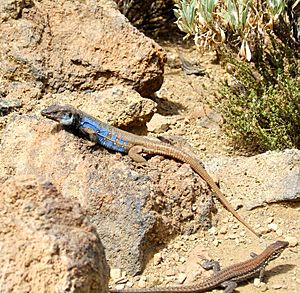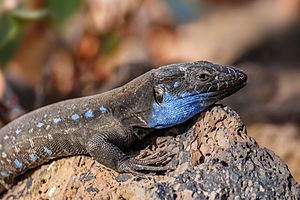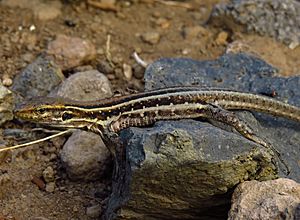Gallotia galloti facts for kids
Quick facts for kids Gallotia galloti |
|
|---|---|
 |
|
| Southern Tenerife lizard, Gallotia galloti galloti, male (top) and female (bottom) |
|
| Conservation status | |
| Scientific classification | |
| Genus: |
Gallotia
|
| Species: |
galloti
|
The Gallotia galloti, also known as Gallot's lizard, the Tenerife lizard, or the Western Canaries lizard, is a type of wall lizard. It belongs to the Gallotia group of lizards. This lizard lives on the Canary Islands of Tenerife and La Palma. Unlike some other larger lizards in its group, G. galloti is quite common. There are four different kinds, or subspecies, of this lizard.
Contents
About Gallot's Lizard
Both the group name, Gallotia, and the specific name, galloti, honor D. Gallot. He was a naturalist who found the first example of this lizard.
The G. galloti species is part of the western group of Gallotia lizards. The different colors of adult males help us tell the northern and southern subspecies apart. The closest relative to G. galloti is the smaller Boettger's lizard. This lizard lives on the islands of El Hierro and La Gomera.
Different Kinds of Gallot's Lizard
There are four recognized subspecies of Gallotia galloti. This includes the main type, which is called the nominotypical subspecies.
- Gallotia galloti eisentrauti Bischoff, 1982 – This is the Northern Tenerife lizard, found in northern Tenerife.
- Gallotia galloti galloti (Oudart, 1839) – This is the Southern Tenerife lizard. It lives in central and southern Tenerife, including the Teide area.
- Gallotia galloti insulanagae Martín, 1985 – This is the Anaga lizard. It lives on Roque de Fuera de Anaga, an island off the Macizo de Anaga mountains in northeastern Tenerife.
- Gallotia galloti palmae (Boettger & L. Müller, 1914) – This is the La Palma lizard, found on the island of La Palma.
What Does it Look Like?
Male G. galloti lizards are bigger than females. Strong males can grow up to 40 centimetres (16 in) long from their snout to the tip of their tail. However, adult males of the G. galloti palmae subspecies are a bit smaller, reaching only about 30 centimetres (12 in) in length.
Adult males of all subspecies have special pale blue patches on their heads and sides. They sometimes also have blue spots on their bodies.
G. galloti is one of the smaller lizards in its western group. Some giant species, like G. auaritae and G. stehlini, can grow twice as long!
Daily Life and Habits
The G. galloti lizard is diurnal, meaning it is active during the day.
It mainly eats leaves, buds, flowers, nectar, and fruits from plants in its home. This makes it an important pollinator and helps spread seeds. It also eats insects and other small creatures without backbones. These lizards lay 3 to 6 eggs at a time, usually between April and August.
Their main enemy is the feral cat. Other animals that hunt them include the common kestrel (a type of bird of prey) and the common raven.
Adult male lizards have bright colors and are very curious. This makes many people like them. In popular places like Teide National Park, these lizards have gotten used to people. They sometimes eat ripe fruit, which can make them a bit of a bother in vineyards and orchards. Because of this, they are sometimes trapped or poisoned. This can cause local groups of lizards to shrink. However, none of the subspecies are currently in danger of disappearing.
Where Does it Live?
G. galloti prefers dry, sunny places. However, you can find it in all kinds of habitats on the western Canary Islands. They live from sea level all the way up to 3,000 metres (9,800 ft) high in the mountains.
The northern type of this lizard lives at lower heights on the north-facing slopes. The southern type lives above the pine forests on the north-facing slopes and on the southern slopes of Tenerife.
The G. g. insulanagae subspecies lives in a very small area. Because of this, it is considered a vulnerable type of animal. But for now, it seems safe because its home is hard to reach and is part of the Parque Rural de Anaga nature park.
See also
 In Spanish: Lagarto Tizón para niños
In Spanish: Lagarto Tizón para niños




